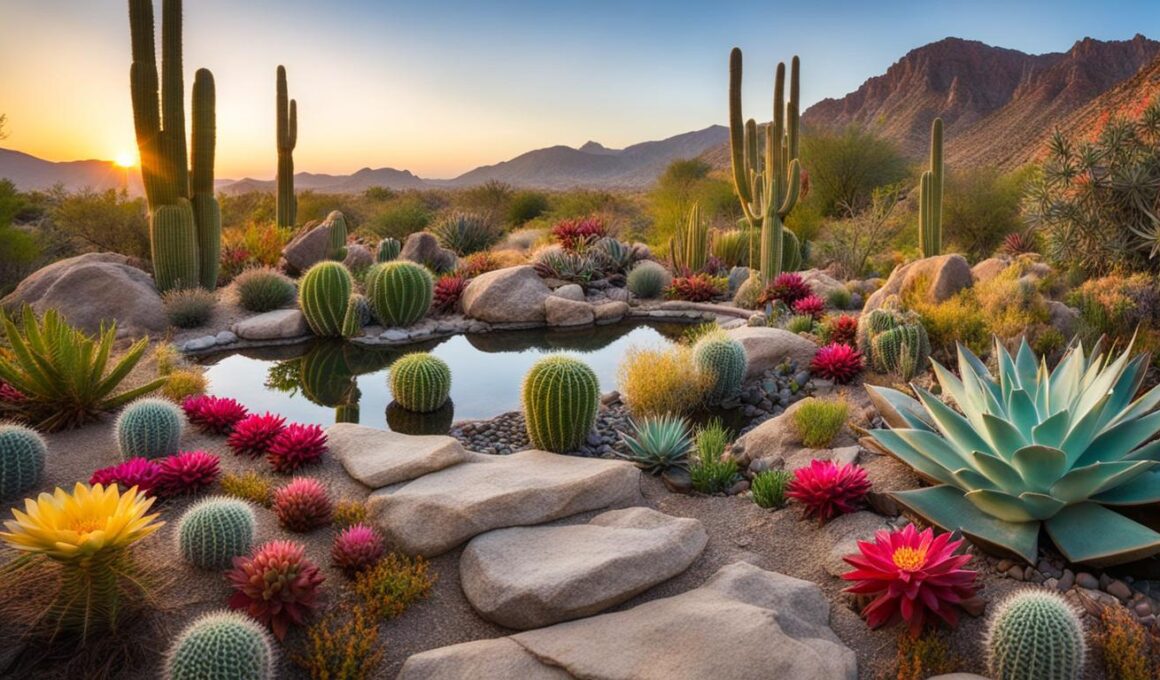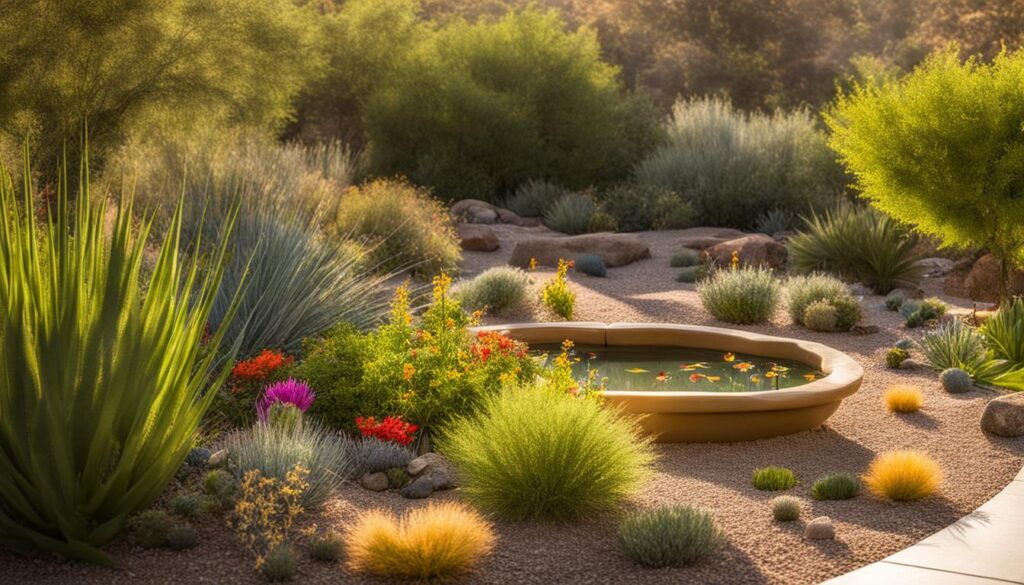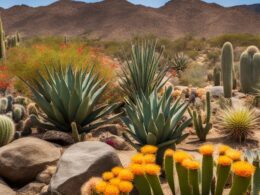Xeriscaping is a landscaping method developed for arid and semi-arid climates that utilizes water-conserving techniques, drought-tolerant plants, and efficient irrigation. By implementing xeriscape ideas, landscapes can save water and attract a diverse range of wildlife. Xeriscaping does not mean removing all plant life; it focuses on choosing the right type of vegetation that fits the climate. Xeriscape landscapes require less maintenance and can help lower water and maintenance bills. Incorporating drought-tolerant plants like cacti, lavender, and thyme alongside efficient irrigation systems such as drip and soaker hoses can help create a thriving and sustainable xeriscape garden.
Key Takeaways:
- Xeriscaping is a landscaping method for arid and semi-arid climates that focuses on water conservation and attracting wildlife.
- It involves utilizing drought-tolerant plants and efficient irrigation systems.
- Xeriscape landscapes require less maintenance and can help lower water and maintenance bills.
- Incorporating drought-tolerant plants and efficient irrigation systems is crucial for creating a thriving xeriscape garden.
- Xeriscaping allows homeowners to create a sustainable garden that supports local ecosystems and conserves water.
The Benefits of Xeriscaping
Xeriscaping offers numerous advantages for homeowners and the environment. By adopting water-conserving techniques and incorporating drought-tolerant plants, xeriscape gardens contribute to water conservation efforts, reducing the strain on local water supplies and helping to mitigate the effects of drought. This not only benefits the community but also results in cost savings for homeowners in the form of lower water bills.
In addition to water conservation, xeriscape gardens require significantly less maintenance compared to traditional grass lawns. With reduced mowing, pruning, and watering needs, homeowners can save time and effort, allowing them to enjoy their outdoor spaces without the constant upkeep. Lower maintenance requirements also translate into cost savings, as homeowners spend less on lawn care services and maintenance equipment.
Furthermore, many cities and municipalities offer xeriscape conversion rebates to incentivize homeowners to make the switch to water-wise landscaping. These rebates provide financial incentives for homeowners who choose to replace water-intensive lawns with drought-tolerant plants and efficient irrigation systems. By taking advantage of these rebates, homeowners can further reduce the initial costs of xeriscaping and accelerate their return on investment.
Designing a Xeriscape Garden
When it comes to designing a xeriscape garden, there are several key principles that you should keep in mind. These principles will help you create a beautiful and sustainable landscape that conserves water and thrives in arid climates.
1. Good Landscape Planning
The first step in designing a xeriscape garden is to carefully plan your landscape. Consider the layout, sun exposure, and natural features of your yard. This will help you determine the best areas for planting and the most effective use of water-saving techniques.
2. Appropriate Turf Areas
Xeriscaping involves reducing or replacing traditional turfgrass areas with low-water-use alternatives. Consider reducing the size of your lawn or replacing it with native grasses or ground covers that require less water. By minimizing turf areas, you can significantly reduce water consumption in your landscape.
3. Efficient Irrigation Systems
An efficient irrigation system is essential for a xeriscape garden. Consider using drip irrigation or soaker hoses to deliver water directly to the roots of plants, minimizing evaporation and runoff. This ensures that water is used efficiently and helps reduce water waste.
4. Use of Soil Amendments and Mulches
Improving the soil quality in your xeriscape garden is crucial for plant health and water conservation. Add organic matter and soil amendments to enhance moisture retention and nutrient availability. Additionally, using mulch around plants helps to conserve moisture, suppress weeds, and regulate soil temperature.
5. Incorporation of Low-Water-Use Plants
One of the main principles of xeriscaping is choosing plants that are well-suited to arid conditions. Select native and drought-tolerant plants that require minimal watering once established. These plants have adapted to the local climate and will thrive with less water, reducing the need for excessive irrigation.
6. Proper Maintenance
Maintaining your xeriscape garden is crucial for its long-term success. Regularly monitor plant health, adjust irrigation as needed, and remove weeds. Prune plants when necessary and replace any struggling plants with more suitable alternatives. By properly maintaining your xeriscape garden, you can ensure its beauty and sustainability over time.
By applying these principles when designing your xeriscape garden, you can create a sustainable and water-efficient landscape that thrives in arid conditions. Reducing turf areas, incorporating native plants, and implementing efficient irrigation systems are key factors in conserving water and creating an environmentally-friendly garden.
Attracting Wildlife to a Xeriscape Garden
If you’re looking to create a sustainable and environmentally-friendly garden, a xeriscape garden is the way to go. Not only does it conserve water and lower maintenance requirements, but it also provides a habitat for wildlife. By choosing native plants for your xeriscape garden, you can attract a diverse range of wildlife and contribute to the conservation of local flora and fauna.
Xeriscape gardens, with their focus on native plants, provide well-adapted food and cover for native animals. Native plants support local ecosystems and help conserve biodiversity. They provide essential food and shelter for birds, butterflies, bees, and other pollinators. By planting a variety of native plants, you can create a wildlife-friendly habitat that reduces the need for pesticides and chemicals, making it even more attractive to wildlife.
When designing your xeriscape garden, consider incorporating features that attract wildlife. Create different levels of vegetation, such as tall trees, shrubs, and ground covers, to provide a variety of habitats. Include bird feeders and bird baths to attract feathered friends. Add a small pond or water feature to provide a water source for amphibians and insects. By including these elements, you can create a garden that not only saves water but also supports a thriving ecosystem.
Benefits of Attracting Wildlife to Your Xeriscape Garden
- Contributes to the conservation of local flora and fauna
- Supports biodiversity by providing food and habitat for native animals
- Reduces the need for pesticides and chemicals
- Creates a thriving ecosystem that is visually appealing
- Brings joy and enjoyment as you observe the wildlife in your garden
“A xeriscape garden not only saves water but also creates a haven for wildlife. By choosing native plants, you can attract a diverse range of animals and contribute to the conservation of local ecosystems.”
In conclusion, attracting wildlife to your xeriscape garden is a rewarding experience. By selecting native plants that provide food and shelter, you can create a thriving habitat that supports local wildlife. Whether it’s birds, butterflies, or pollinators, your xeriscape garden can be a vibrant and sustainable haven for a diverse range of species.
How Does Xeriscaping Support Wildlife Attraction and Habitat Creation?
Xeriscaping for wildlife habitat involves using native, drought-resistant plants to create a sustainable landscape that supports local wildlife. By minimizing the need for water and maintenance, xeriscaping provides a natural habitat for animals and insects, contributing to a more biodiverse and ecologically friendly environment.
Choosing Native Plants for a Xeriscape Garden
When creating a xeriscape garden, selecting the right native plants is crucial for its success. Native plants are well-adapted to the local climate and soil conditions, making them naturally drought-tolerant and resilient. By incorporating these plants into your xeriscape garden, you can conserve water while still enjoying a beautiful and vibrant landscape.
Native plants also play a vital role in creating a wildlife-friendly habitat. They provide food and shelter for various species of birds, butterflies, bees, and other pollinators, contributing to the overall biodiversity of your garden. By choosing native plants, you can create an ecosystem that supports and sustains local wildlife populations.
It is important to avoid using invasive non-native plants in your xeriscape garden. These plants can quickly spread and outcompete native species, leading to a loss of biodiversity and potentially harming local ecosystems. Instead, opt for native alternatives that offer similar aesthetic appeal and ecological benefits. Consulting with local nature centers, botanical gardens, or Cooperative Extension agents can provide valuable guidance on selecting native plants and avoiding invasive species.
When choosing native plants for your xeriscape garden, consider their water requirements, growth habits, and visual appeal. Native grasses, wildflowers, shrubs, and trees are excellent choices that can thrive with minimal water and maintenance. Incorporating a variety of plant species will provide texture, color, and interest to your garden throughout the year.
By carefully selecting and incorporating native plants into your xeriscape garden, you can create a sustainable and visually stunning landscape that not only conserves water but also supports wildlife and promotes the health of your local environment. So start exploring the diverse range of native plants available in your area and create a xeriscape garden that is both beautiful and eco-friendly.
Conclusion
Xeriscape gardening is a sustainable landscaping approach that combines water conservation with creating a habitat for wildlife. By implementing xeriscape ideas and using drought-tolerant native plants, homeowners can reduce water usage, lower maintenance requirements, and attract a diverse range of wildlife.
Xeriscaping not only benefits homeowners by saving costs but also contributes to water conservation efforts and supports local ecosystems. By choosing native plants and avoiding invasive species, homeowners can create a beautiful and thriving xeriscape garden while providing food and shelter for wildlife.
Start xeriscaping today and let nature thrive in your garden.












